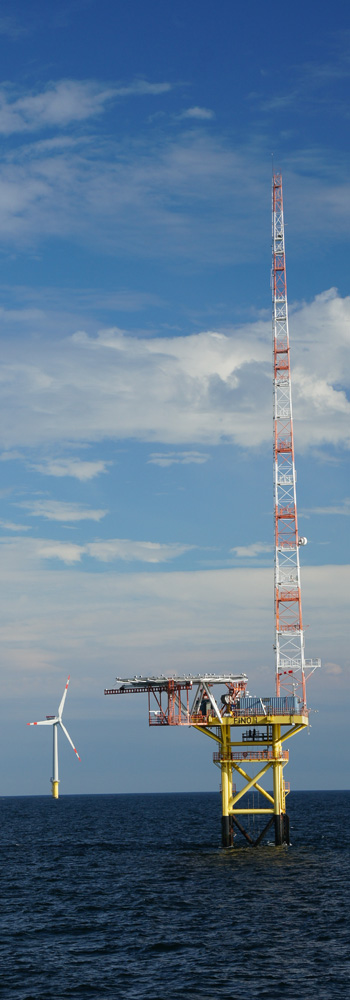A special focus of the work of the Research Alliance for Wind Energy (FVWE) involves innovative and practical methods for the planning, construction and operation of wind farms. In order to reduce the costs and risks involved in these phases along the value chain, new techniques and tools were developed in collaboration with the industry.
Site Assessment
Reliable qualification of the wind conditions at onshore and offshore locations is a top priority for the successful commercial operation of a wind farm. Additional data, for example on the seabed, accessibility and other relevant parameters, are required for the various project phases. The FVWE develops innovative measurement procedures for the reliable and cost-effi cient collection and allocation of the required data. Here the main emphasis is on the development of models for describing natural turbulence, even in topographically complex areas, the logging of wind speed using Lidar, seismic seabed investigations and satellitesupported prediction methods. Acoustic models are also being developed for site and installation assessment purposes.
Logistics and Construction Techniques
The ongoing increase in the size of wind turbines and their installation at complex onshore and offshore sites calls for wellconsidered logistic processes and special transport and construction solutions. The construction of offshore wind farms in particular is a real challenge for engineers: complicated and interlinked construction schedules have to be completed within a few months under challenging environmental conditions. The Research Alliance produces optimized construction concepts for this phase of the project which, for example, help minimize pile-driving noise levels during installation and reduce the overall building time. In order to support the working sequences and improve planning reliability, the FVWE also provides work-schedule simulations based on several years of weather time series and in this way contributes to the professional development of the offshore wind energy sector.

Operation
Operating a wind turbine means facing a series of challenges, including a very high number of load cycles within the 20-year operating life, extreme climatic conditions and difficult accessibility. Factors such as component reliability and the use of optimized service strategies are of decisive importance for the cost-effective operation of the turbine.
The FVWE is involved in a large number of projects alongside well-known operators, OEMs and component suppliers, where solutions are being developed for a wide range of operational problems. Failure statistics are systematically analyzed and root-cause investigations are carried out on defective components. The existing test infrastructure provides a unique opportunity for reproducing specifically targeted environmental conditions and stress levels and validating the investigations in time lapse mode. This generates a broad base of operational experience and application knowhow that can be continuously exploited for the further improvement of equipment and operating concepts with a view to increasing installation availability.
The FVWE is also testing and validating innovative condition monitoring systems, particularly for complex applications in the field of fiber composites and power electronics. Preventing and assessing turbine damage caused by environmental factors will greatly reduce maintenance and repair costs and make for better reliability levels and lower electricity production costs.
